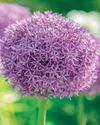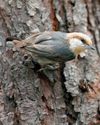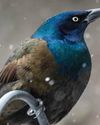
The word "oriole" originally came from a Latin term meaning "the golden one." Although the name was first applied to an unrelated group of birds in Europe, Asia and Africa, it's perfectly appropriate for the American orioles. These birds belong to the blackbird family (along with grackles, red-winged blackbirds and meadowlarks) and they have the same sharply pointed beaks typical of that family.
Eight oriole species are found regularly north of the Mexican border, and you can find at least one or two of these in almost any area of the United States during summer. Many male orioles in northern locations are more brightly patterned than females, but the sexes often look the same among those seen further south.
Female orioles build impressive nests. They weave plant fibers into a cup or a hanging pouch that's often suspended near the end of a branch, hidden by leaves, providing a cradle for the young that's safe from most predators.
Official Colors: Baltimore Oriole
As early as the 1720s, people in the eastern colonies called this species the Baltimore bird because the male's orange and black colors suggested the coat of arms of a British nobleman, Lord Baltimore, the same person for whom the city in Maryland was named. The term oriole wasn't added to the bird's name until decades later. Baltimore orioles are common in summer across most of the eastern states and southeastern Canada, with smaller numbers spending the winter in the southeastern states.
Western Cousin: Bullock's Oriole
This story is from the April/May 2024 edition of Birds & Blooms.
Start your 7-day Magzter GOLD free trial to access thousands of curated premium stories, and 9,000+ magazines and newspapers.
Already a subscriber ? Sign In
This story is from the April/May 2024 edition of Birds & Blooms.
Start your 7-day Magzter GOLD free trial to access thousands of curated premium stories, and 9,000+ magazines and newspapers.
Already a subscriber? Sign In

Basics of Hydroponics
Use these top tips and plant picks to have a successful soil-free garden

Rooted in Resilience
These hardy perennials will thrive in most zones

Social and Supportive
Brown-headed nuthatches take a helpful approach to raising their young

All About Owl Pellets
And why you should give a hoot about them

Ask the Experts
Advice from our pros about houseplants, bird feeding and more

BRING THE OUTDOORS IN
Making a terrarium is about as close as you can get to a Zen DIY project. Once you have gathered the proper materials and squared away your plant selections, it's as simple as layering it all together and watching your mini ecosystem thrive. Here, I'll walk you through my foolproof process and cover all the required elements for good filtration, healthy soil, strong root growth and resistance against fungus and disease.

GROW THIS. NOT THAT
Six easy-to-grow houseplants—and six that may not be the right choice for you

Winter MAGIC
Forecasts may be frigid, but grab your binoculars because birding opportunities are still incredible

Sense or Nonsense? - Why some birds can taste and smell - but others can't
Does a porcelain berry taste like a blueberry to a gray catbird? Does a block of lard smell like frying bacon to a northern flicker? The short answer is no. While some avian species do have a well-adapted sense of taste or smell, they can't distinguish between flavors and odors the way humans can. They're not picking up every ingredient in the suet you put out, says José Ramírez-Garofalo, an ornithology researcher at Rutgers University in New Jersey and the director of Freshkills Biological Station in Staten Island, New York.

Maple Mania - Amazing facts about this fall foliage mainstay
Amazing facts about this fall foliage mainstay
